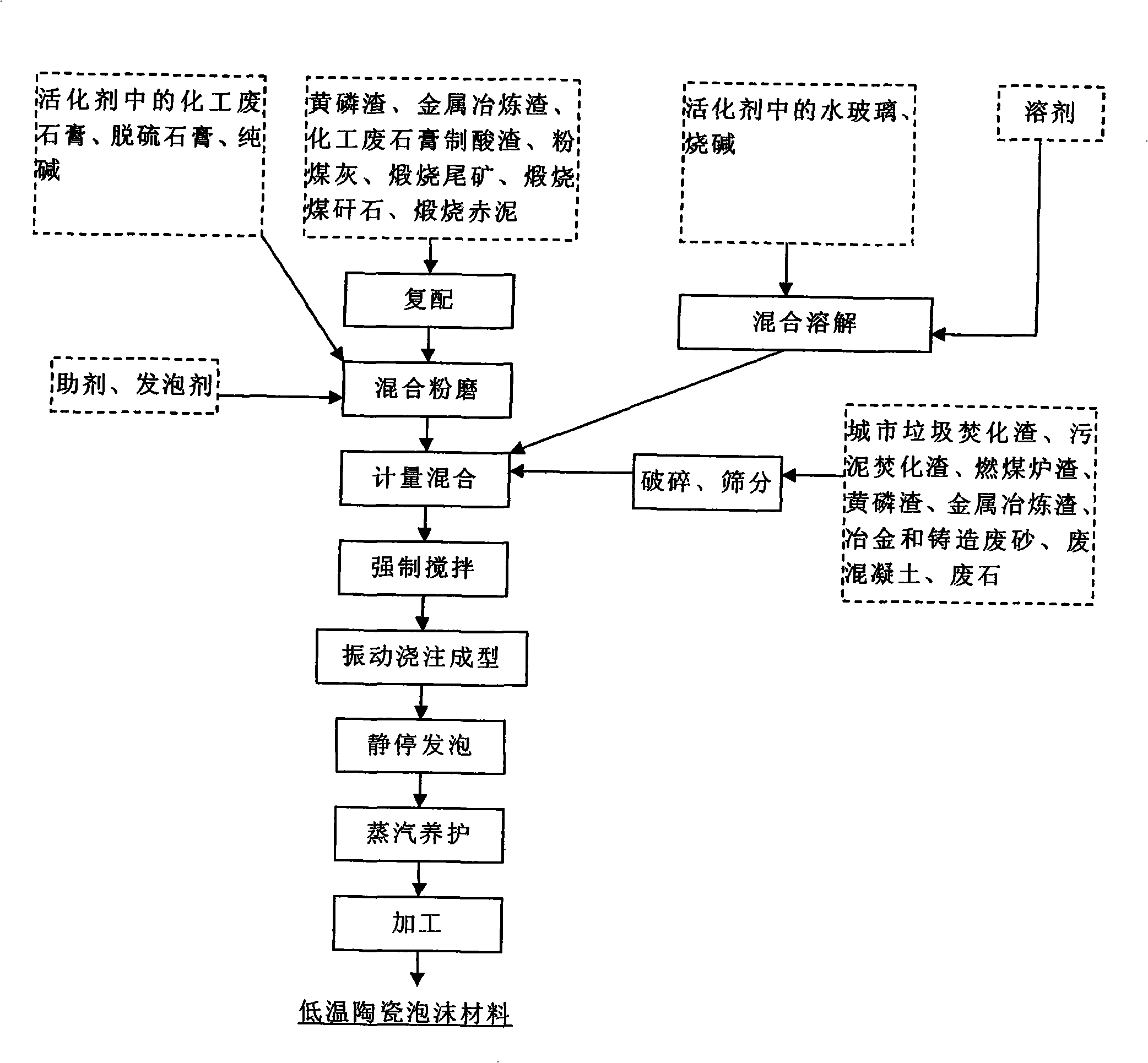Low-temperature ceramic foam material and production method thereof
A technology of foam materials and low-temperature ceramics, applied in the field of low-temperature ceramic foam materials and its production, to achieve the effects of low energy consumption, high production efficiency, and low investment
- Summary
- Abstract
- Description
- Claims
- Application Information
AI Technical Summary
Problems solved by technology
Method used
Image
Examples
Embodiment 1
[0050] 1) Formula composition (substance measurement units are parts by mass):
[0051] The raw material of cementitious material is 70 parts of yellow phosphorus slag, 20 parts of fly ash, and 10 parts of blast furnace slag; the raw material of aggregate is 50 parts of yellow phosphorus slag, 50 parts of foundry waste sand; the foaming agent aluminum powder is 1.0 parts; the activator is 9 parts of water glass, 0.5 parts of sodium carbonate, 2.5 parts of caustic soda, 1 part of desulfurized gypsum; additives are 0.8 parts of calcium lignosulfonate, 0.7 parts of sodium humate, 0.7 parts of borax, 0.3 parts of sodium phosphate, and 0.3 parts of calcium fluorosilicate 0.2 parts of sodium fluorosilicate; 15 parts of water;
[0052] 2) Process: the cementitious material raw material measured according to the formula and sodium carbonate, phosphogypsum, calcium lignosulfonate, sodium humate, borax, sodium phosphate, calcium fluorosilicate, sodium fluorosilicate, aluminum powder, bl...
Embodiment 2
[0055] 1) Formula (substance measurement units are parts by mass)
[0056] The cementitious material is 20 parts of blast furnace slag, 20 parts of fly ash, 40 parts of calcined red mud, and 20 parts of calcined alumina tailings; the raw material of aggregate is 100 parts of cinder, 300 parts of construction waste concrete; the activator is 30 parts of water glass , 6 parts of caustic soda, 14 parts of desulfurized gypsum; additives are 0.7 parts of naphthalenesulfonate, 0.07 parts of sodium phosphate; foaming agent is 0.06 parts; water is 50 parts of red mud wastewater containing alkali
[0057] 2) Process:
[0058] The cementitious material raw material measured according to the formula is blended with desulfurized gypsum, naphthalenesulfonate, sodium phosphate, and foaming agent to grind into a powder with a particle size of less than 0.08mm, accounting for 92%; the aggregate is first crushed and sieved to become 0.6 -5mm coarse particle filler which accounts for 91%; re...
Embodiment 3
[0061] 1) Formula composition (substance measurement units are parts by mass):
[0062] The cementitious material is 30 parts of thermal manganese slag, 30 parts of phosphogypsum acid slag, 20 parts of calcined coal gangue, and 20 parts of steel slag; the aggregate is 50 parts of municipal waste incineration slag, 50 parts of sludge incineration slag, and 100 parts of copper slag , 50 parts of waste concrete, 50 parts of waste brick; 26 parts of water glass as activator, 5 parts of soda ash, 0.5 part of fluorine gypsum; 0.19 part of naphthalene sulfonate as auxiliary agent, 0.019 part of borax; It is 38 parts of alkali-containing steamed condensed water;
[0063] 2) Process: The cementitious material raw material measured according to the formula is blended with soda ash, fluorogypsum, naphthalene sulfonate, borax, and foaming agent to grind into a powder with a particle size of less than 0.08mm, accounting for 97%; the aggregate is crushed, sieved Sub-processing becomes 0.6-...
PUM
| Property | Measurement | Unit |
|---|---|---|
| Compressive strength | aaaaa | aaaaa |
| Flexural strength | aaaaa | aaaaa |
| Density | aaaaa | aaaaa |
Abstract
Description
Claims
Application Information
 Login to View More
Login to View More - R&D
- Intellectual Property
- Life Sciences
- Materials
- Tech Scout
- Unparalleled Data Quality
- Higher Quality Content
- 60% Fewer Hallucinations
Browse by: Latest US Patents, China's latest patents, Technical Efficacy Thesaurus, Application Domain, Technology Topic, Popular Technical Reports.
© 2025 PatSnap. All rights reserved.Legal|Privacy policy|Modern Slavery Act Transparency Statement|Sitemap|About US| Contact US: help@patsnap.com

